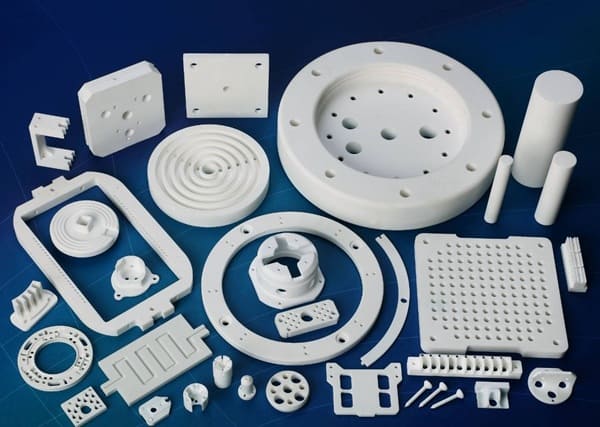Benefits of Macor Ceramic in High-Temperature Environments
Macor ceramic is a machinable glass-ceramic material widely used in industries requiring excellent thermal, mechanical, and electrical properties at elevated temperatures. Its unique combination of machinability and high-temperature resistance makes it an increasingly popular choice for critical components in electronics, aerospace, and energy sectors. This article explores Macor’s benefits, characteristics, and applications in high-temperature environments.
At Advanced Ceramic Hub, we specialize in high-quality ceramic products, ensuring optimal performance for industrial and scientific applications.

What Is Macor Ceramic?
Macor is a glass-ceramic material composed mainly of fluorophlogopite mica and borosilicate glass. It is distinguished by its ability to be machined like metals, while providing ceramic-level thermal and electrical performance.
| Property | Typical Value | Importance in High-Temperature Use |
| Maximum Operating Temp | 1000°C | Suitable for many moderate to high-temperature uses |
| Thermal Conductivity | 1.46 W/m·K | Controls heat flow, preventing hotspots |
| Dielectric Strength | 15-25 kV/mm | Excellent electrical insulation |
| Coefficient of Thermal Expansion (CTE) | 9.3 x 10^-6 /°C | Reduces thermal stress during heating/cooling |
| Machinability | Very High | Allows complex, precise component fabrication |
Its machinability, coupled with thermal resistance, makes Macor versatile in many industrial fields.
Explore our high-quality macor products.
What Thermal Advantages Does Macor Offer in High-Temperature Settings?
Macor’s ability to withstand temperatures up to about 1000°C without degradation is crucial in applications like furnace components, heating elements, and electronic insulators. Its low thermal conductivity helps reduce heat transfer, while the controlled CTE lowers the risk of cracking due to thermal expansion mismatch.
Thermal Properties Comparison Between Macor and Other Ceramics:
| Material | Max Temp (°C) | Thermal Conductivity (W/m·K) | CTE (10^-6 /°C) | Thermal Shock Resistance |
| Macor | 1000 | 1.46 | 9.3 | Moderate |
| Alumina (Al2O3) | 2072 | 20-30 | 6.5 | High |
| Zirconia (ZrO2) | 2715 | 2-3 | 10-12 | Very High |
| Mullite | 1840 | 5-7 | 5-6 | Moderate |
Though Macor’s max temperature is lower than some ceramics, its machinability and stable thermal properties fill a niche in many moderate to high-temp applications.
How Does Macor’s Mechanical Strength Support High-Temperature Performance?
Macor’s unique microstructure provides a balance between strength and machinability. While it does not match alumina’s hardness or zirconia’s toughness, it offers enough mechanical strength for insulating parts, supports, and fixtures under moderate thermal stress.
Mechanical Properties Relevant to High-Temperature Use:
- Flexural Strength: ~110 MPa
- Compressive Strength: ~380 MPa
- Hardness (Mohs): 5
- Impact Resistance: Moderate compared to dense ceramics
This strength is adequate for many components exposed to heat but low mechanical loads.
Why Is Macor’s Electrical Insulation Important in High-Temperature Applications
Many high-temperature industrial processes require reliable electrical insulation at elevated temperatures. Macor excels here with a high dielectric strength and stable resistivity, even near its upper operating temperature.
| Electrical Property | Macor Value | Significance |
| Dielectric Strength | 15-25 kV/mm | Prevents electrical breakdown |
| Volume Resistivity | >10^14 ohm·cm | Maintains insulation over long periods |
| Dielectric Constant | ~6.5 | Stable across wide temperature range |
This makes Macor ideal for heater insulators, spark plugs, and electronic component supports in hot environments.
How Does Macor Compare to Other Ceramic Materials in High-Temperature Uses?
Macor’s standout feature is machinability combined with decent thermal and electrical properties. While alumina and zirconia excel in temperature resistance and mechanical strength, they are brittle and harder to machine. Macor can be processed using standard metalworking tools, enabling complex shapes and fast prototyping.
Comparison of Macor and Other Ceramics for High-Temperature Use:
| Feature | Macor | Alumina | Zirconia | Silicon Carbide |
| Max Temp (°C) | 1000 | 2072 | 2715 | 2700 |
| Machinability | Excellent | Poor | Poor | Very Poor |
| Mechanical Strength | Moderate | High | Very High | High |
| Electrical Insulation | Excellent | Good | Moderate | Poor |
| Cost | Moderate | Moderate | High | High |
Macor’s unique machining ability offers distinct advantages for custom parts in moderately high-temperature environments.
Request a custom quote for the Macor products.
What Are the Common Applications of Macor in High-Temperature Environments?
Macor ceramics find applications where a combination of thermal resistance and machinability is required:
- Electrical insulators for heating elements
- Furnace parts like supports and fixtures
- Vacuum system components
- High-temperature seals and gaskets
- Components in the aerospace and electronics industry
Benefits of Driving These Applications:
- Custom-shaped parts are possible without costly sintering molds
- Low thermal conductivity improves energy efficiency
- Electrical insulation ensures the safe operation of heaters and sensors
What Are the Manufacturing and Machining Advantages of Macor?
Unlike many ceramics, Macor can be machined using conventional metalworking tools such as lathes, mills, and drills. This reduces lead times and allows rapid prototyping or small-batch production of complex parts.
| Machining Method | Description | Benefits |
| Conventional Milling | Precise shaping and cutting | Fast turnaround, high accuracy |
| Drilling | Creates holes without cracking | Enables complex assemblies |
| Turning | Produces cylindrical shapes | Cost-effective for batch runs |
| Polishing | Surface finishing for smoothness | Improves dielectric performance |
These manufacturing advantages make Macor highly attractive in R&D and specialized industrial settings.
What Future Trends Are Emerging for Macor Ceramic Use?
Emerging trends in Macor applications include:
- Enhanced composites: Adding reinforcements to improve toughness.
- 3D printing and additive manufacturing: For more complex shapes.
- Eco-friendly production: Lower energy sintering methods.
- Hybrid parts: Combining Macor with metals or other ceramics for optimized performance.
Such developments aim to broaden Macor’s usability in demanding high-temperature industrial sectors.
FAQ
| Question | Answer |
| What is the max operating temperature? | Approximately 1000°C, suitable for many heating and insulation needs. |
| Can Macor withstand thermal shock? | It has moderate thermal shock resistance, suitable for controlled heating. |
| Is Macor machinable like metals? | Yes, it can be machined using standard metalworking tools. |
| How does Macor’s electrical insulation perform? | Excellent dielectric strength and volume resistivity at high temps. |
| What industries commonly use Macor? | Aerospace, electronics, energy, vacuum systems, and furnace parts. |
Conclusion
Macor ceramics’ combination of machinability, moderate thermal resistance, and excellent electrical insulation fills a critical niche in industrial applications where complex custom parts are needed. Though its max temperature is lower than some advanced ceramics, its ease of manufacturing and stable properties make it invaluable for many moderate to high-temperature uses. As innovation continues, Macor is set to expand its role in aerospace, electronics, and energy sectors, offering versatile and cost-effective solutions.
For expert-grade Macor ceramic products tailored to your high-temperature needs, Heeger Materials provides reliable materials and customization services to boost your operational performance and product longevity.
Looking for high-quality ceramic products? Contact us today!
